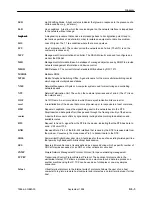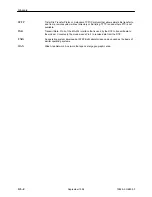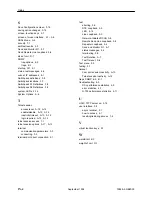
Glossary
GL-3
7986-A2-GB20-00
September 1998
Light Emitting Diode. A light or status indicator that glows in response to the presence of a
certain condition (e.g., an alarm).
Line LoopBack. A test in which the received signal on the network interface is looped back
to the network without change.
A diagnostic procedure that sends a test message back to its origination point. Used to
test various portions of a data link in order to isolate an equipment or data line problem.
Loss of Signal. The T1 line condition where there are no pulses.
Line Termination Unit. The control unit on the network end of a link. (The NTU is on the
customer premises end.)
Management Communications Controller. The DSLAM circuit card used to configure and
monitor the DSLAM.
Management Information Base. A database of managed objects used by SNMP to provide
network management information and device control.
MIB Release 2. The current Internet-standard MIB, defined by RFC 1213.
Multirate SDSL.
Mobile Telephone Switching Office. A generic name for the main cellular switching center
which supports multiple base stations.
Network Management System. A computer system used for monitoring and controlling
network devices.
Network Termination Unit. The unit on the customer premises end of a link. (The LTU is on
the network end.)
Out Of Frame. An error condition in which frame synchronization bits are in error.
A reinitialization of the device that occurs at power-up or in response to a reset command.
Repeater LoopBack. Loops the signal being sent to the network back to the DTE
Drop/Insert and data ports after it has passed through the framing circuitry of the device.
A device that connects LANs by dynamically routing data according to destination and
available routes.
Request to Send. A signal from the DTE to the device, indicating that the DTE has data to
send. V.24 circuit 105.
Received Data. Pin 3 of the EIA-232 interface that is used by the DTE to receive data from
the modem. Conversely, the modem uses Pin 3 to transmit data to the DTE.
Symmetrical Digital Subscriber Line. A technique for the use of an existing twisted pair line
that permits high bandwidth, bidirectional transmission.
Severely Errored Seconds. Usually defined as a second during which a specific number of
CRC errors was exceeded, or an OOF or other critical error occurred.
Simple Network Management Protocol. Protocol for open networking management.
Transmission Control Protocol/Internet Protocol. The dominant protocol suite in the
worldwide Internet, TCP allows a process on one machine to send data to a process on
another machine using the IP. TCP can be used as a full-duplex or one-way simplex
connection.
Virtual terminal protocol in the Internet suite of protocols. Allows the user of one host
computer to log into a remote host computer and interact as a normal terminal user for that
host.
LED
LLB
loopback
loopback
LOS
LTU
MCC
MIB
MIB II
M/SDSL
MTSO
NMS
NTU
OOF
reset
RLB
router
RTS
RXD
SDSL
SES
SNMP
TCP/IP
Telnet
Summary of Contents for M/HDSL Standalone Termination Unit HOTWIRE...
Page 68: ...Testing 5 10 7986 A2 GB20 00 September 1998 This page intentionally left blank...
Page 80: ...Security 7 6 7986 A2 GB20 00 September 1998 This page intentionally left blank...
Page 106: ...Standards Compliance for SNMP Traps B 6 7986 A2 GB20 00 September 1998...
Page 114: ...Technical Specifications D 2 7986 A2 GB20 00 September 1998 This page intentionally left blank...






































